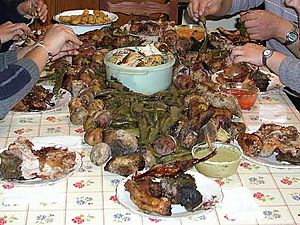Pachamanca facts for kids
Pachamanca is a very old and special dish from Peru. Its name comes from the Quechua language, where pacha means "earth" and manka means "pot". So, it's like "earth pot" cooking! This meal is unique because it's baked using hot stones in an earthen oven. This type of oven is called a huatia.
People usually make Pachamanca with different kinds of meat. This can include lamb, mutton, alpaca, llama, pork, beef, chicken, or even guinea pig. The meat is first soaked in a special mix of herbs and spices. Many other tasty things are also baked with the meat. These often include potatoes, sweet potatoes, Lima beans, corn, and chili peppers.
This amazing dish has been around since the time of the Inca Empire. Over many years, it has become popular all over modern Peru. There are some small differences in how it's made in different areas. You can also find similar dishes in other Andean countries, like Ecuador.
Where is Pachamanca Made?
Pachamanca is mostly made in the central part of the Peruvian Andes mountains. Here are some of the main places:
- In the upper Huallaga valley, near Huánuco and Pasco. Here, they often use pork and special local herbs like chincho and huacatay.
- In the Mantaro valley, around cities like Huancayo, Tarma, and Jauja. They usually use lamb and different seasonings here.
- In several areas of the Ayacucho department.
Pachamanca is not as common in the Peruvian Amazon jungle, the southern Andes, or the desert coast. This is because it's hard to find enough firewood or the right kind of stones in those places. Sometimes, meat is wrapped in marmaquilla or chincho leaves before it goes into the earthen oven.
How is Pachamanca Cooked?
Cooking Pachamanca is a special process that takes time and care. It's like a big outdoor cooking event!
The process starts by heating many stones over a fire until they are super hot. Then, the seasoned meat and vegetables are placed on top of these hot stones. The whole cooking area is then covered with grass and earth. This creates a natural, underground oven. After about two hours, the "oven" is carefully opened up. Usually, a large amount of food is cooked at once, sometimes even a whole sheep, to feed many people.
See also
 In Spanish: Pachamanca para niños
In Spanish: Pachamanca para niños







